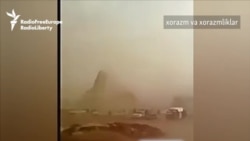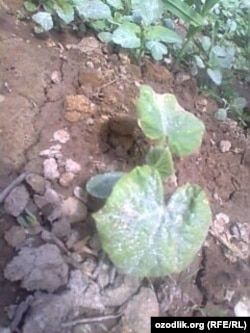Residents of Turkmenistan's northern Dashoguz Province are being sent back out into the fields, although this time they're neither sowing nor harvesting. They're trying to save the crops from withering.
High winds picked up dust and salt from the desiccated Aral Sea on May 26-27 and blew it all over northern and eastern Turkmenistan, as well as Uzbekistan's western Bukhara, Khorezm, and Navoi provinces and its Karakalpakstan Autonomous Republic.
Images captured after the storm resemble winter scenes of a light snowfall blanketing cars, roads, and vegetation. But it's salt, in some places a centimeter thick.
Eighty-year-old Temirbek bobo, a pensioner in Karakalpakstan, told RFE/RL's Uzbek Service, known locally as Ozodlik, he had never seen anything like it.
He couldn't have. There's never been anything in the region like this salt storm. And unfortunately, it may well happen again.
A correspondent for RFE/RL's Turkmen Service, known locally as Azatlyk, said authorities in Dashoguz were pressing "teachers and [other] state employees" out into the fields at daybreak on May 29 to remove as much of the salt as possible from fruits and vegetables, and wheat and cotton fields.
The only means they have is reportedly to wash it off, which cleans the crop but deposits the salt into the soil. The same is likely to be happening in Lebap Province.
There have been shortages of basic goods, notably flour, in Turkmenistan since autumn 2016. The country is experiencing its worst economic crisis since it became independent in late 1991. It may therefore lack the money to carry out the sort of decontamination work that the fields of Dashoguz and Lebap need to yield any kind of a decent harvest. But Turkmenistan also cannot afford to lose the crops in two of its five provinces.
Dashoguz was already in bad shape. The Alternative Turkmenistan News website reported in April that salt was accumulating on the surface of the ground there. This storm has compounded an existing problem.
But Turkmenistan's government also appears to be employing a default tactic when faced with a crisis: Don't talk about it. There has been no official acknowledgement of this freak storm or its negative effects, and no request for outside help. (Authorities in Turkmenistan have declared this an Era of Happiness. If there's never any bad news, there's never any reason to ask for help from abroad.)
But there is no reason to believe that Turkmen authorities bear responsibility for this dust-salt storm.
A Glimpse Of The Future?
It is the likely result of the environmental disaster that is the Aral Sea, located several hundred kilometers north of Turkmenistan along the Uzbek-Kazakh border. Seventy-five years ago, it was the fourth-largest saline lake in the world; but less than 10 percent of it remains, due in large part to the overuse of rivers that once fed the Aral Sea. In its place is a large area of alkaline soil and salt.
Kazakhstan has successfully stemmed the desiccation in its part of the Aral, but Uzbekistan's section continues to dry up.
The Central Asian states have vowed many times to work together to save the Aral Sea, most recently on March 15 at a Central Asian summit in Astana. But it continues to shrink. It's certainly a problem that all five countries share. Small amounts of salt from this latest storm reached all the way to Bishkek, in Kyrgyzstan, some 1,000 kilometers to the east.
Much of the Aral Sea once covered the area now called Karakalpakstan. People of that region suffer from an assortment of maladies that many blame on the ecological circumstances -- respiratory and diarrheal disease, for example, higher-than-normal maternal- and infant-mortality rates, and psychological problems associated with decreasing opportunities in an area that is becoming less habitable.
That might be the future for more areas in Central Asia. The storm was one of the clearest signs so far of what awaits the western regions of Central Asia if nothing is done to reverse the process of the drying Aral Sea. High winds are not new to this region, but salt storms are. This latest event suggests the desiccation of the Aral Sea has reached a point where the resulting salt can easily be whipped up by dust storms and dumped onto fields and orchards hundreds of kilometers away.
So Dashoguz marks a new phase in one of the first battles in a long war. Dashoguz is located in the northern part of the Karakum (Garagum) Desert. Agriculture there faces challenges at the best of times. With little water and temperatures already exceeding 40 degrees Celsius, the salt on and in the ground is going to take a toll on crops, leaving many in Turkmenistan hungrier.
It's Turkmenistan's problem today. But it will increasingly be one for all of Central Asia.









